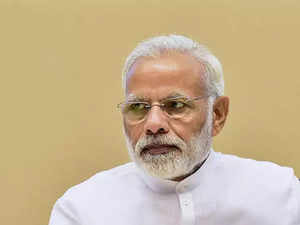
Oil bonanza helped Modi tide over fiscal troubles. But now it seems, Modi's oil luck is running out.
Oil rose above $65 a barrel for the first time since mid-2015 on Tuesday as an unplanned shutdown of the UK's biggest North Sea oil pipeline supported a market already tightened by Opec-led production cuts.
India is heavily dependent on imports for a large chunk of the crude oil that it consumes. In 2016-17, around 82.1 per cent of the oil consumed in India, was imported.
The net rate of exports is one of the contributing factors to a country's GDP. The higher the imports, the bigger negative impact it has on the net rate. So with oil prices on the decline since 2014, it meant that the export metric in GDP calculation did not have as severe a negative hit.
Between 2011 and 2014, the average price of crude oil was $108.5 per barrel, and the average between 2014 and 2017 was $59.3 per barrel. In 2014, IMF Chief Christine Lagarde had said that a 30 per cent dip in oil prices would lead to at least 0.8 per cent growth in most advanced economies, since they are all importers of oil. Eventually, crude oil prices fell almost double that rate.
A 2014 report from Macquarie Capital Securities India said a $10 per barrel fall in oil prices would reduce India's import bill and the current account deficit by $9.2 billion (0.43% of the then GDP).
Due to falling oil prices India’s macro-economic indicators such as inflation, current account deficit (CAD), and trade balance improved. On the back of contraction in the trade deficit, the CAD came down to $22.1 billion, or 1.1 per cent of GDP from $26.8 billion, or 1.3 per cent of GDP, in 2014-15.
In the last three years, despite the fall in global crude oil prices, the average Indian consumer of petroleum products has not been a beneficiary of it. Instead, increased excise duty and VAT on petrol and diesel has meant that despite the 56 per cent fall in oil prices, the prices of petrol and diesel are at most 5 per cent less than what they were in May 2014.
Since June 2014, when international oil prices started declining, India has increased its excise duties from Rs 15.5 per litre to Rs 22.7 per litre as of December 2016 for branded petrol and from Rs 5.8 per litre to Rs. 19.7 per litre for branded diesel. In contrast, the governments of most advanced countries simply passed on the benefits to consumers.
Modi now faces a situation critical for his party's fortunes in the next Lok Sabha polls. With oil prices increasing, an unchanged excise duty would mean that the end consumer would have to pay even more, while a cut in excise duty would mean that petroleum companies will not be able to reap the benefits of the revival in the industry.
The government thinks the oil prices are within the range where they cannot upset the fiscal math.
However, the Economic Survey presented in Parliament earlier this year painted a slightly different picture: "Even if prices rose merely to $60-65/barrel, the Indian economy would nonetheless be affected by way of reduced consumption; less room for public investment; and lower corporate margins, further denting private investment. The scope for monetary easing might also narrow, if higher oil prices stoked inflationary pressure."
This is also a time of faltering domestic crude oil and gas production and output cuts announced by the Organization of the Petroleum Exporting Countries (Opec).
India is one of the major Opec consumers. 85 per cent and 94 per cent of India’s crude oil and gas imports respectively come from the Opec countries.
The IMF has recently advised the Opec nations to move away from oil as the only source of income, which could mean a further increase in the price of crude oil.
Read More News on
Download The Economic Times News App to get Daily Market Updates & Live Business News.
Read More News on
Download The Economic Times News App to get Daily Market Updates & Live Business News.









 Get Unlimited Access to The Economic Times
Get Unlimited Access to The Economic Times
